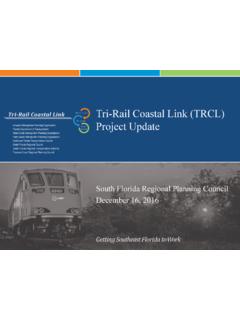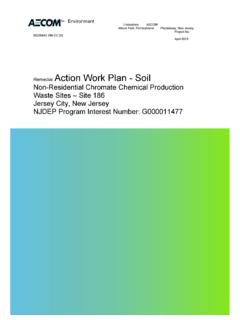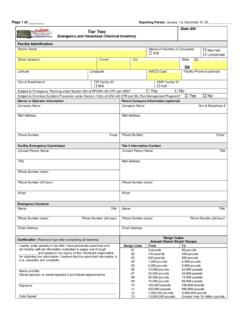Transcription of 1 Project Execution Plan - buildingSMART Australasia
1 Document id Title Organisation / Author Date Status xxx IFC Infra Overall Architecture Project plan TUM / Andr Borrmann 29/01/2016 final 1 project execution plan Having standardized infrastructure asset data available throughout the lifecycle of the facility is an im- portant key to a higher efficiency in planning, constructing, operating and maintaining our infrastructure. A comprehensive neutral data model capable to present both semantic as well as geometric aspects is necessary for enabling data exchange and open data access in the context of planning, realization and maintenance of road and rail infrastructure. Recently, a number of national standardization initiatives have emerged which developed proposals for standardized data exchange schemata. Examples are the Korean IFC-Road Project , the Chinese IFC-Rail Project and the IFC-Bridge Project led by the French chapter.
2 Due to the overlapping scope of the diverse national initiatives, partly concurrent data elements have been proposed. In order to harmonize the diverse proposals and provide a sound foundation for the future international standardization of Road, Rail, Bridge and Tunnel data exchange formats, this Project will provide a framework which will serve as common basis for all infrastructure activities. The framework includes commonly used data structures such as the spatial aggregation hierarchy for linear (horizontal) facilities as well as guidelines regarding the data modeling such as the maximum inheritance level or the use of enumeration types. Particular attention is paid to enabling a future integration of GIS and InfraBIM systems by ensuring best possible compatibility between the proposed IFC-Infra extensions and the InfraGML data model.
3 This is achieved by developing a joint conceptual model using UML class diagrams. This Project development plan describes the necessary steps to develop the integration framework. Objectives The IFC Infra Integration Framework is set to achieve: Analysis of the currently available drafts of the IFC infrastructure extension initiatives with respect to joint / overlapping areas Project , including the IFC-Road Project by the Korean chapter (note: the Korean IFC-Road Project had already been analysed and modifications had been suggested by MSG). the IFC-Rail Project by the Chinese chapter the IFC-Bridge Project led by the French chapter Definition of jointly used data structures as a common basis, including terrain geometry earthwork geometries (cut and fill volumes). subsoil modelling cant / super elevation clearance spatial aggregation hierarchy for linear assets Provision of modelling guidelines for bSI Infrastructure extension projects consistent extension of the different class trees for spatial structure, element and element type structure, element breakdown structure common criteria for the class inheritance structure (by infrastructure discipline, like IfcBridgeEle- ment, IfcRoadElement, IfcRailElement, or by common functionality).
4 Common criteria for reusing existing classes from the building domain, like IfcWall, IfcSlab maximum class inheritance levels usage of object type libraries usage of enumerations and property sets usage of coordinate reference system usage of alignment and linear references for positioning purposes preferred geometry description method for identified use cases Ability to map common infrastructure information between InfraGML (developed by OGC) and en- hanced version of IFC. A foundation for standardized data exchange during the entire lifecycle, including requirements, de- sign, construction, operation, maintenance and destruction/recycling These objectives have to be realized within the current architecture of the IFC schema and shall lead to a downward compatible extension. Deliverables In order to achieve the objectives the following main deliveries are developed during the Project A clear definition of the scope for common infrastructure information in this standard and references to other standards covering other scopes relevant for infrastructure information.
5 In order to provide context to all other descriptions, this includes the definition of a reference process description in the form of a high level process map containing and defining the most important stages, stakeholders and exchanges A clear definition (ontology) of common infrastructure information in the scope of this standard as the conceptual schema jointly developed by buildingSMART and OGC using UML. The general extension to the buildingSMART IFC4 schema comprising the common infrastructure model, delivered as a recommendation to enhance the EXPRESS schema in a consistent way A modelling guideline for the infrastructure domain specific projects on how to consistently extend the IFC structure Facilitation of two review panels From client and domain expert side to state the requirements and assess the solution From software vendor side to assess the implementability of the solution Project Execution The Project work is carried out by the Project team.
6 At least one member of the Project team is member of buildingSMART Model Support Group (MSG) to carry out the schema extension. The Project leader will be determined and leads the Project team. The work is supervised by the Infrastructure Integration steering committee of the Infrastructure room, where the stakeholders are adequately represented (see Figure 1). The steering committee will nominate a representative to be the direct contact person for the Project leader. The Project leader reports to the steering committee and will work closely with the steering com- mittee representative during the Execution of the Project . Proposal: Steering committee representative for the Infrastructure Integration Project Henk Schaap Project leader Andr Borrmann, Technical University Munich, Germany The steering committee (in close collaboration with the Project leader) will invite client representatives, domain experts, and software vendor representatives to participate in the Expert panel.
7 Page no. Author 2 Andr Borrmann, Thomas Liebich The Project team is supported by management support staff for building up the expert panel, workshop invitations, taking minutes and distributing minutes and materials. Figure 1 Organisational structure, in accordance with the Infrastructure Room Charter 2 Work plan The work plan of the Infra Integration Project is based on existing work experience coming from IFC- Alignment development and preliminary work in buildingSMART , OGC, and other initiatives. Existing Work The Project will built upon the significant work by the Korean IFC-Road Project , the Chinese IFC-Rail pro- ject and the IFC-Bridge Project led by the French chapter. All three projects have defined extensive data models for describing infrastructure assets. However, the projects have developed mostly independent from each other.
8 In consequence, diverging or even incompatible approaches to modeling commonly used exist. The proposed Project will analyze in detail the proposed data models and incorporate them to the largest extent possible. The Project will also take into consideration the ongoing Infra Asset Management Requirements Project , as well as other relevant activities, such as Japanese developments on Tunnels. Beside the IFC-related initiatives, there are also other data models. LandXML is a widely adopted quasi standard for representing roads. However, it has a number of modelling errors and it is no longer actively maintained. The Finnish infrastructure clients initiated the Finnish Inframodel development1, it docu- ments and enhances for well-defined use cases; this development has also lead to buildingSMART Recommended Technical Report 2(adopted by InfraRoom in March 2015).
9 1 See 2 See Page no. Author 3 Andr Borrmann, Thomas Liebich OGC has created a Land and Infrastructure working group with the goal to develop InfraGML3. OKSTRA4 is used for road information systems in Germany. OKSTRA standard is only target for the Ger- man market, since the complete data model is in German language. OpenBrIM5 is an XML file format for bridges, however it is only poorly supported by software packages. In the Singapore bSI Standards Summit Fall 2015, the Infrastructure room concluded the following resolu- tion: . The InfraRoom resolves to establish an Overall Architecture Working Group to address the issues of integra- tion across the evolving Infrastructure standards development. The InfraRoom appreciates the results from the discussion of issues during the session on Integration. The InfraRoom acknowledges the work done by national IFC development programs on Roads, Railways, Bridges and Tunnels, and asks that they provide their conceptual schemas as a resource for the Overall Archi- tecture.
10 The InfraRoom acknowledges the urgency of developing the Overall Architecture for Infrastructure Exten- sions and asks all parties involved to take this into account.. Project work package structure The work packages (WP) of the Infra Integration Project are: WP0 Completion of Project Execution plan Based on the Project proposal and the Memorandum of Understanding a full Project Execution plan has to be developed, showing work packages, deliverables, work schedule, budget plan , Project team and the Project organization in terms of responsibilities and reporting lines. Tasks: Development of Project Execution plan Agreement of Project Execution plan Deliverable: Completed Project Execution plan Milestone: M0, WP 1 Requirement Analysis Analyze the requirements of existing data exchange processes in infrastructure projects.






